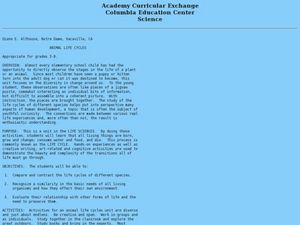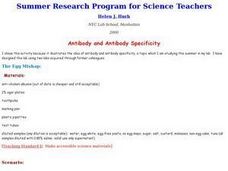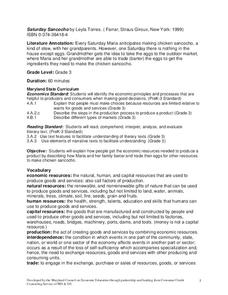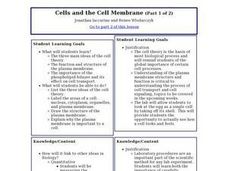Curated OER
The Shape of Things
Students study the natural incubation of hens and the important characteristics of the egg shell. They perform experiments to test the strength of the dome shape of an egg and prove that an eggshell has pores to allow air to pass. ...
Curated OER
Eggs
Students know the following parts of an egg as the yolk, white, shell, membrane, chalaza, and air sac. They also sequence the growth of the chick in the egg. An egg is broken and students touch, smell and see it. They locate the six...
Curated OER
Egg Toss
This cross curricular lesson involves eggs. Students read about eggs. A counting game involving an egg carton and ping pong balls (eggs) is played as students toss balls into numbered egg carton cups and adding their score. Students...
Curated OER
Confetti Eggs
Students create confetti-filled eggs in this easter, or spring, Art lesson for the elementary school classroom. The lesson includes resource links and a game idea involving the created confetti eggs to celebrate any occasion.
Curated OER
Egg Count
Students practice writing addition and subtraction sentences. They use an activity sheet to count white and browm eggs and solve addition and subtraction problems. Aftterwards, they write addition and subtraction sentences.
Curated OER
WHAT ANIMALS GIVE US?
Pupils examine how animals on a farm provide us with many resources.
Curated OER
Animal Life Cycle
Students conduct hands-on experiments. In this life cycle activity, students are able to observe a variety of animals as they travel through their life cycle (brine shrimp, mealworms, frog eggs and chicken eggs). Students respond to...
Curated OER
Get Cracking
Students compare the life cycle of an animal hatched from an egg with one born from its mother's womb. The lesson plan focuses on dinosaur eggs. They create dinosaur eggs from balloons and papier mache.
Curated OER
How do Hypotonic, Hypertonic, and Isotonic Solutions Affect the Water Movement of a Cell?
After removing the shell from a raw egg, cell biologists soak the egg in either a hypotonic, hypertonic, or isotonic corn syrup solution. They calculate the percent change in mass and compare it to the strength of the solution in a...
Curated OER
Geometry and Measurement
Young geometers explore relationships between units of measure and objects. Three activities provide varied opportunities to practice. Learners calculate the volume of two cylinders made by rolling a piece of paper vertically and...
Serendip
Introduction to Osmosis
A chicken egg is a very large cell—perfect for investigating osmosis! Scholars conduct an experiment with vinegar and eggs that helps them understand the process of osmosis. They follow the activity with an in-depth look at osmosis in...
Curated OER
Hatching Chicks to Agriculture - Where does the feed come from?
Second graders examine the types of grain that goes into feed for chickens. They study other grain crops grown in Kansas and the foods that are made from them.
Curated OER
Oviperous Animals
Students explore animals that come from eggs using pictures and information taken from the Internet. The reading of the stories, "Chickens Aren't the Only Ones" and"Tap Tap, the Egg Cracked" is used as a introduction to the topic.
Curated OER
What's Hatching in Kindergarten?
Students identify oviparous animals. They brainstorm a list of animals that lay eggs, read "Chickens Aren't The Only Ones" by Ruth Heller and then add to the list. Students complete a booklet that shows an egg and an oviparous animal.
Curated OER
Dr. Seuss Lesson Plan
Students read classic children's books. In this Dr. Seuss instructional activity, students read the Seuss classics The Cat in the Hat, Green Eggs & Ham and Horton Hears a Who. Students create models based on story characters and...
Curated OER
A Recipe for Reading: Asian Style Rice and Eggs
Learners read, write about, and cook with rice in this home economics lesson plan. They reflect on the experience eating rice at home or in other ethnic foods.
Curated OER
Poultry
Here is a simple lesson that combines reading, coloring, and a puzzle for young learners. In it, pupils read the selection Great Pumpkins, then they color in the hen puzzle with colors based on the three distinct categories that the...
Curated OER
Antibody and Antibody Specificity The Egg Mishap
Pupils investigate a set of foods to find the presence of eggs after designing an experiment that will complete the test. They complete a test and discuss antibody-antigen specificity.
Curated OER
I am a Proto-Chicken!
Students exercise their imaginations and use their writing and drawing skills to show what they have learned about Protoarchaeopteryx modesta, the proto-chicken. This is a creative project that is graded based upon originality and...
EngageNY
End of Unit Assessment Parts 1 and 2: Evaluating Arguments and Claims
Which came first: the chicken or the egg? As part of the end-of-unit assessment for The Omnivore’s Dilemma, scholars watch a video about organic eggs versus conventional farm eggs. They use graphic organizers to collect evidence as they...
NOAA
Deep-Sea Ecosystems – A Tale of Deep Corals
Many have debated which came first, the chicken or the egg, but this lesson plan debates which came first, the hydrocarbons or the carbonate reef. After a discussion on deep-sea corals, scholars receive a set of questions to research and...
Curated OER
Saturday Sancocho
Second graders identify the economic principles and processes that are helpful to producers and consumers when making good decisions. Students will read, comprehend, interpret, analyze, and evaluate literary text as well as explain how...
Curated OER
Cells and the Cell Membrane
Learners investigate the properties of cell membranes by isolating the membrane surrounding chicken eggs. They set up an experiment by placing eggs in a vinegar solution for three days. A powerpoint lecture emphasizes the structure of...
Curated OER
Observing Osmosis in a Chicken Egg
Tenth graders develop a hypothesis and explain what they observed on an activity. In this investigative lesson students observe osmosis and report their data using a graph.







